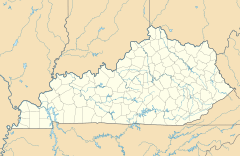Cranks, Kentucky facts for kids
Quick facts for kids
Cranks, Kentucky
|
|
|---|---|
| Country | United States |
| State | Kentucky |
| County | Harlan |
| Elevation | 1,467 ft (447 m) |
| Time zone | UTC-4 (Eastern (EST)) |
| • Summer (DST) | UTC-4 (EST) |
| ZIP codes |
40820
|
| GNIS feature ID | 490292 |
Cranks is a small place in southeastern Harlan County, Kentucky, United States. It's close to the Virginia state line. Cranks is an unincorporated community. This means it's a group of homes and businesses that don't have their own local government, like a city or town. Instead, the county government handles its services. The land here is quite high, ranging from about 1,683 to 2,933 feet above sea level. The main road through Cranks is U.S. Route 421.
Contents
Cranks Creek Lake: A Fun Place to Visit
Cranks is home to the beautiful Cranks Creek Lake. This lake is part of the Martins Fork of the Cumberland River. It's a popular spot for outdoor activities.
Lake History and Size
The lake was finished in 1963. It covers a normal area of about 219 acres. That's like having 165 football fields of water!
Fishing and Boating
Many kinds of fish live in Cranks Creek Lake. You can find rainbow trout, largemouth bass, and smallmouth bass. There are also spotted bass, bluegill, and channel catfish. Boating is allowed on the lake. However, if your boat has an engine bigger than 10 horsepower, you must go at an idle speed. This helps keep everyone safe and protects the lake.
Exploring Wildlife Areas
Cranks is also a great place for nature lovers. It has two special areas for wildlife.
Cranks Creek Wildlife Management Area
This area is dedicated to protecting animals and their homes. It's a wonderful spot to see local wildlife.
Stone Mountain Wildlife Management Area
This area is another important place for nature. It includes a very unique feature called the wagon road.
The Historic Wagon Road
The wagon road is a hand-built road and tunnel. It was made a long time ago. People living on the Cranks Creek side of Stone Mountain used it. This road helped them reach the railroad line on the Virginia side. It was a clever way to connect communities through the mountains.



